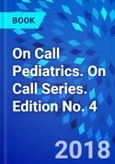Ideal for any on-call professional, resident, or medical student, this popular reference covers the common problems you'll encounter while on call without direct supervision in the hospital. On Call Pediatrics, 4th Edition, fits perfectly in your pocket, ready to provide key information in time-sensitive, challenging situations. You'll gain speed, skill, and knowledge with every call - from diagnosing a difficult or life-threatening situation to prescribing the right medication.
- Features a logical, highly templated format so you can locate key information quickly.
- Reviews the indications for, and complications of, common neurodiagnostic tests.
- Delivers consistent, easy-to-follow coverage of the most common on-call problems and approaches, including what to do from the initial phone call, questions you should ask to assess the urgency of each situation, "Elevator Thoughts," how to immediately identify major threats to life, what to do at the bedside, and how to avoid common mistakes for every call.
- Provides updated content and references, as well as an up-to-date drug formulary, keeping you on the cutting edge of current, evidence-based information.
- Expert ConsultT eBook version included with purchase. This enhanced eBook experience allows you to search all of the text, figures, and references from the book on a variety of devices.
Table of Contents
On Call Pediatrics, 4eIntroduction
1. The Diagnosis and Management of On-Call Problems
2. Communicating with Colleagues and Families
3. Common Mistakes
4. Remembering your ABCs
5. Teaching (and Learning) While on Call
Patient-Related Problems
6. Abdominal Pain
7. Altered Mental Status
8. Analgesics and Antipyretics
9. Bleeding
10. Chest Pain
11. Constipation
12. Crying and the Irritable Infant
13. Cyanosis
14. Delivery Room Problems
15. Diarrhea and Dehydration
16. Extremity Pain
17. Eye Problems and Visual Abnormalities
18. Fever
19. Gastrointestinal Bleeding
20. Genitourinary Problems
21. Headache
22. Heart Rate and Rhythm Abnormalities
23. Hematuria
24. Hypertension
25. Hypotension and Shock
26. Lines, Tubes, and Drains
27. Rashes
28. Respiratory Distress
29. Seizures
30. Urine Output Abnormalities
31. Vomiting
Laboratory-Related Problems
32. Acidosis and Alkalosis
33. Anemia, Thrombocytopenia, and Coagulation Abnormalities
34. Electrolyte Abnormalities
35. Glucose Disorders
36. Hyperbilirubinemia
Appendices
A. Pediatric Procedures
B. Resuscitation Calculations
C. Calculation of Creatinine Clearance
D. Calculation of Alveolar-Arterial Oxygen Gradient








